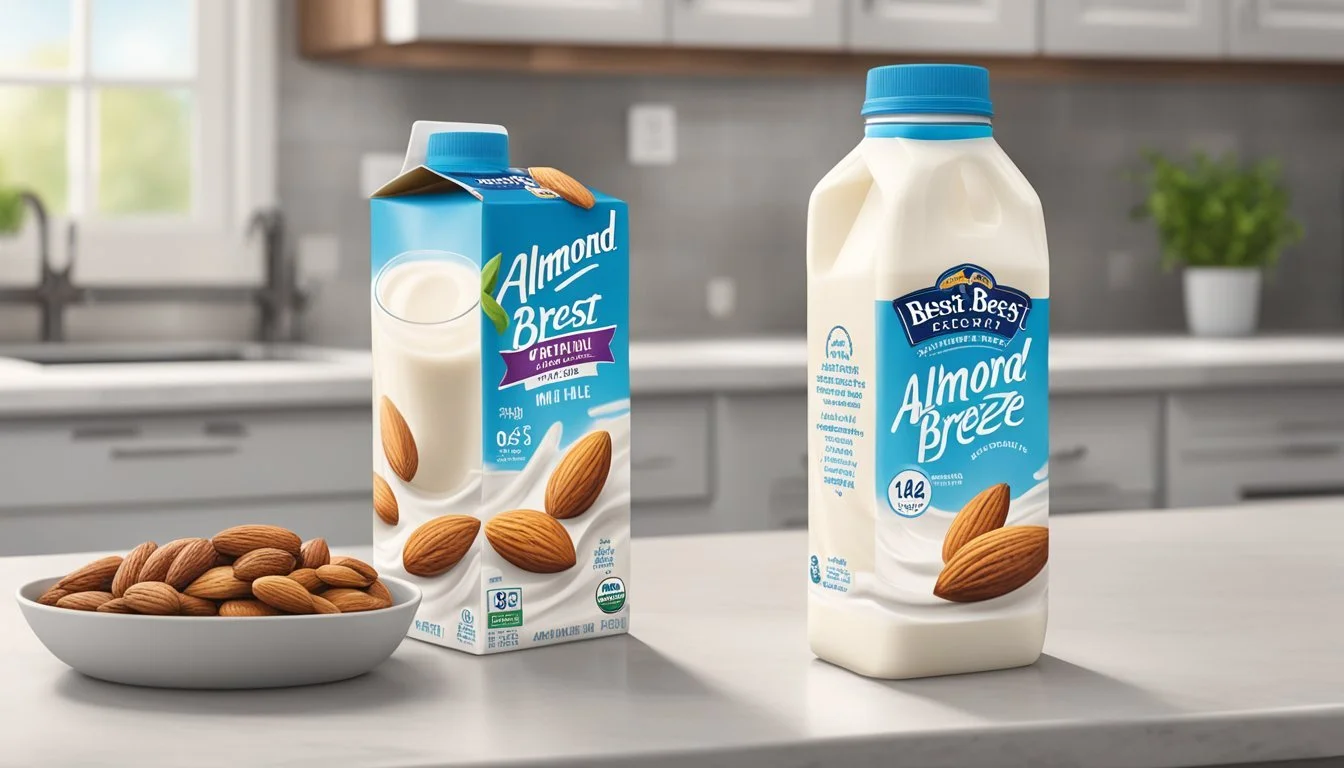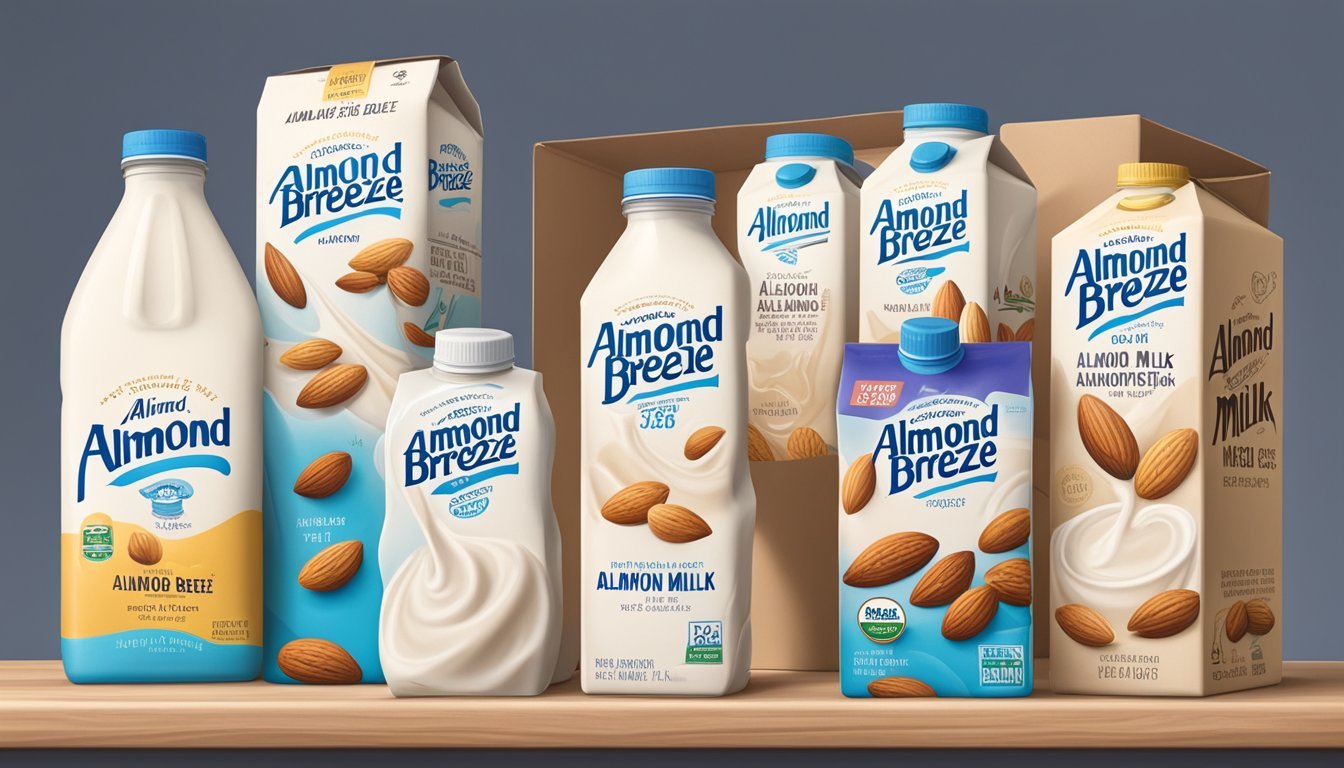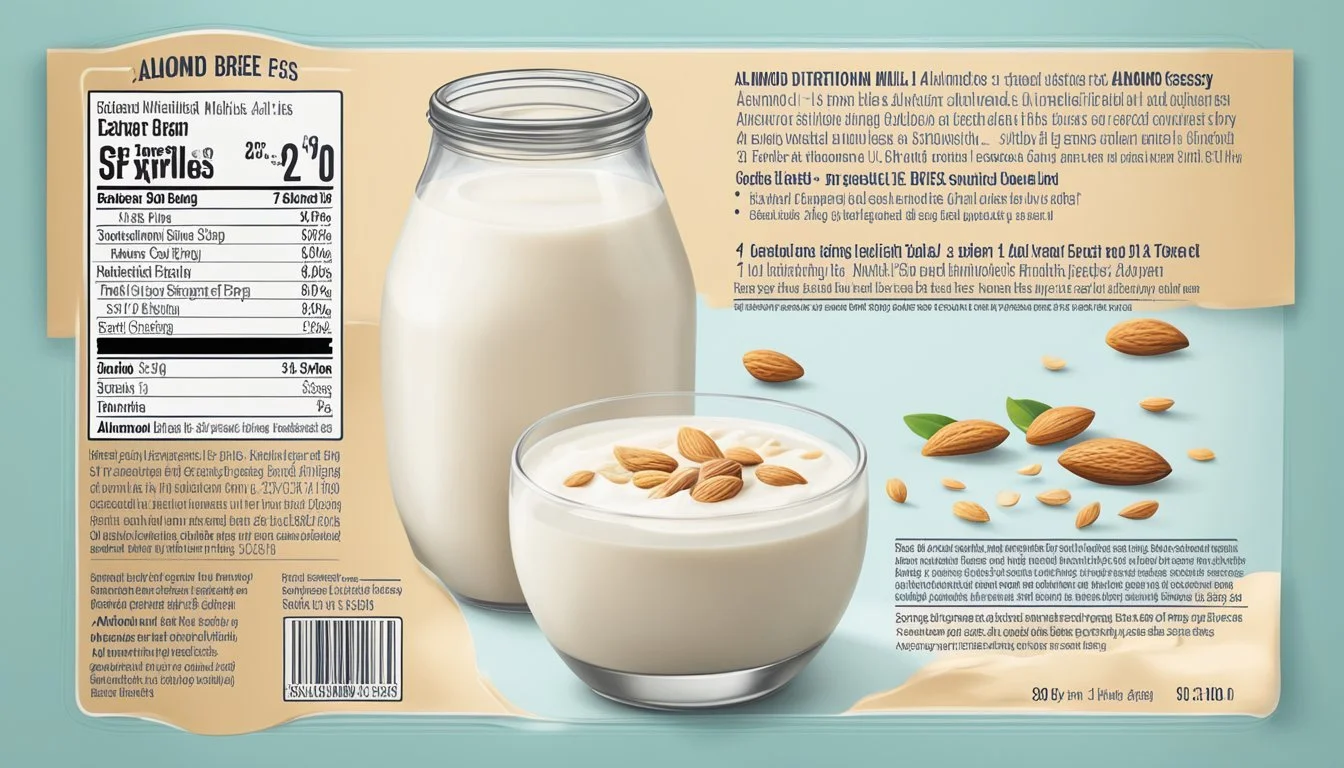How Long Does Almond Breeze Almond Milk Last?
Shelf Life and Storage Tips
Almond milk has become a popular dairy alternative, offering a lactose-free, vegan option for consumers. Among the various brands available, Almond Breeze is a common choice found on grocery shelves. The shelf life of almond milk is a key consideration for consumers who want to enjoy its benefits while ensuring food safety and quality. When unopened and stored properly, Almond Breeze almond milk can last for several months in the refrigerator; it is imperative to adhere to the expiration date marked on the packaging for optimal freshness.
Once opened, the window during which Almond Breeze maintains its freshness diminishes. Typically, open almond milk should be consumed within 7 to 10 days when refrigerated. Proper storage is critical in preserving its quality—opened cartons must be kept refrigerated and sealed tight to prevent spoilage. Shelf-stable varieties of Almond Breeze, which can be stored at room temperature until opened, also follow similar guidelines after opening, requiring refrigeration and consuming within 7 to 10 days.
Almond milk's perishability is one aspect where it aligns with dairy milk, despite the differences in their compositions. Both are susceptible to microbial contamination and require careful handling. Consumers who prefer homemade almond milk should consume it within 3-4 days when refrigerated, due to the lack of preservatives and sterilization processes present in commercially produced alternatives like Almond Breeze. Whether homemade or store-bought, tasting almond milk before use is a good practice to ensure it hasn't spoiled.
Determining Almond Milk Shelf Life
The shelf life of Almond Breeze and other almond milk brands varies significantly based on whether the product is shelf-stable or refrigerated, as well as its storage conditions. Accurately determining the shelf life ensures both safety and quality of the product.
Understanding Shelf-Stable vs Refrigerated Almond Milk
Shelf-stable almond milk is processed in such a way that it can be stored at room temperature until its expiration date. These cartons usually remain good for 12 to 24 months when kept in a cool, dry place such as a pantry. On the other hand, refrigerated almond milk typically has a shorter shelf life and must be stored in the refrigerator even when unopened; it generally lasts up to several months depending on the expiration date.
Recognizing Expiration Dates and Packaging Information
When purchasing almond milk, one should always check the expiration date stamped on the carton. For unopened shelf-stable almond milk, consumers can rely on the "best by" or "best before" dates. Once opened, both shelf-stable and refrigerated almond milks should be consumed within 7-10 days, and continuous refrigeration is crucial.
Importance of Storage Conditions and Temperature
The storage condition of almond milk directly influences its longevity. Almond Breeze and similar products should be kept away from direct sunlight and sources of heat. Unopened shelf-stable milk should be stored at a consistent temperature. Refrigerated almond milk, once opened, must be kept at a cold temperature typically below 40°F (4°C) to maintain its freshness for the expected time frame of 7-10 days.
Proper Storage Techniques
Proper storage of Almond Breeze almond milk significantly affects its shelf life, ensuring freshness and safety. This section outlines the specific measures to be taken for different storage methods.
Best Practices for Refrigeration
When storing Almond Breeze almond milk in the refrigerator, it should remain unopened and upright in its original carton. For shelf-stable almond milk, refrigeration is necessary only after opening and it should be consumed within 7-10 days. It's essential to keep the temperature consistent, ideally below 40°F (4°C), to maintain its freshness.
Maintain the fridge temperature below 40°F (4°C)
Consume opened shelf-stable almond milk within 7-10 days
Guidelines for Freezing Almond Milk
Freezing Almond Breeze almond milk is not recommended by the manufacturer as it may negatively impact the texture and taste. If one must freeze it, using an airtight container is crucial to prevent freezer burn and contamination. Once thawed in the refrigerator, it should be used within the same 7-10 day period and should be shaken well before consumption due to potential separation.
Use an airtight container to prevent freezer burn
Shake well after thawing due to potential separation
Storing Homemade Almond Milk
Homemade almond milk does not contain preservatives and therefore has a shorter lifespan than its commercial counterparts. It should be stored in the refrigerator in an airtight container or pitcher and consumed within 3-5 days.
Refrigerate promptly in an airtight container
Consume within 3-5 days for optimal freshness
Identifying Spoilage Signs
When assessing whether Almond Breeze almond milk has gone bad, one should be mindful of changes in the product's sensory attributes and packaging integrity. These signs may include odd smells, visual spoilage indicators, and textural changes.
Changes in Smell and Taste
Almond Breeze should typically have a nutty and slightly sweet scent and taste. If the product emits a sour or off smell, it indicates spoilage. The taste may become unpleasantly sour or bitter when it has gone bad, distinctly different from its fresh state.
Visual Clues of Mold and Texture Alterations
A visual inspection can be quite telling. Mold presence, visible as green or black spots, is a clear indication of spoilage. Additionally, if the milk has become clumpy or has a noticeably thicker texture than usual, these are signs that it should not be consumed. A bloated carton can also signify fermentation and spoilage inside the package.
What to Do When Almond Milk Goes Bad
If one determines that their Almond Breeze is showing any signs of spoilage, they should not consume it. It is important to dispose of the spoiled almond milk to prevent ingestion, which could lead to foodborne illness. To avoid any risks, once spoilage is identified, curdled milk or milk with an off smell must be thrown away immediately.
Health and Safety Considerations
When choosing Almond Breeze as a dairy-free milk alternative, it is important for consumers to be aware of health and safety protocols. Those who are lactose intolerant or adhering to vegan diets can find it a safe and suitable choice; however, recognizing the risks associated with the consumption of spoiled almond milk is vital to prevent food poisoning.
Dairy-Free and Lactose Intolerance Factors
Almond milk, including Almond Breeze, serves as a popular choice for individuals who are either lactose intolerant or seeking vegan alternatives to dairy milk. As it is plant-based, it contains no dairy, making it a lactose-free option. Consumers with lactose intolerance can safely consume Almond Breeze without the risk of the digestive discomfort that dairy milk may cause.
Risks of Consuming Spoiled Almond Milk
Ingesting spoiled almond milk can lead to food poisoning, with symptoms that may include stomach upset, diarrhea, and vomiting. Safety is paramount; thus, it is crucial to consume almond milk before the expiration date. An opened carton of Almond Breeze should be kept refrigerated and preferably used within 7-10 days to minimize the risk of spoilage. Unopened cartons have a longer shelf-life but should always be stored according to package instructions and consumed by the expiration date.
Nutritional and Dietary Information
Almond Breeze almond milk offers a unique nutritional profile when compared to other non-dairy milks, enriched with vitamins and additives to cater to dietary needs.
Comparing Almond Milk to Other Non-Dairy Milks
Almond milk, including brands like Almond Breeze, typically contains lower calories than other non-dairy milk options such as oat, coconut, or rice milk. Here's how it compares:
Oat Milk: Higher in calories and carbohydrates, often enriched with vitamins and minerals.
Coconut Milk: Higher in saturated fat content, with a creamy texture and distinct flavor.
Soy Milk: A good source of protein and usually fortified with vitamins. It is closer in nutritional value to dairy milk.
Rice Milk: High in carbohydrates, low in protein, usually fortified with vitamins but less nutritionally dense.
Hazelnut Milk: Similar to almond milk with a generally low protein content but rich in flavors.
Vitamins and Additives in Almond Milk
Almond milk is frequently fortified to improve its nutritional value. The following are typically added to enhance its profile:
Vitamin E: Almond milk naturally contains Vitamin E, an antioxidant that helps protect the body from free radicals.
Calcium: Since almond milk is not naturally high in calcium, it is often fortified to levels similar to or higher than dairy products.
Preservatives: To extend shelf life, brands might add preservatives, though not all do.
Almond milk is a preferred option for those looking to limit calorie intake or avoid dairy, and with fortification, it remains a nutritionally relevant alternative.
Practical Uses and Recipes
Almond Breeze almond milk offers a creamy texture and nutty flavor, making it a versatile non-dairy milk for everyday use and in an array of culinary creations.
Incorporating Almond Milk in Daily Consumption
Almond Breeze almond milk is a staple for those seeking non-dairy milk options with a creamy texture and nutty flavor. It fits seamlessly into daily diets, whether one is pouring it over cereal or blending it into smoothies. Due to its freshness, an opened carton should be consumed within 7-10 days, as per pasteurization standards ensuring safety and quality.
Cereal: A bowl of cereal with Almond Breeze adds a splash of nutty flavor.
Smoothies: For a nutritious breakfast or snack, blend Almond Breeze with fruits and vegetables.
Coffee and Tea: Use it to lighten hot beverages, contributing a creamy consistency without overpowering them.
Cooking and Baking: Substitute dairy milk with Almond Breeze in recipes to maintain a rich texture.
Creative Ideas for Expired Almond Milk
While one should never consume any perishable product past its expiration date, slightly out-of-date Almond Breeze can be safely utilized in non-edible ways, provided it's not spoiled.
Beauty Treatments: Expired Almond Breeze can be part of a homemade facial mask, offering nourishment due to its vitamin E content.
Plant Fertilizer: Diluted almond milk can provide plants with calcium, although one should be cautious and do so infrequently to avoid spoilage and smell.
It is important to use one's discretion with the use of almond milk that has passed its optimal freshness date and to always prioritize health and safety.
Consumer Advice
When purchasing almond milk, it's important for consumers to consider the type and brand of product, the milk's shelf life, and how to interpret label information to ensure freshness and quality.
Selecting the Best Brands and Varieties
Customers should seek out brands that maintain high-quality standards, such as using non-GMO almonds and avoiding unnecessary additives. Shelf-stable varieties like Tetra Pak packaged almond milk offer a longer shelf life due to the ultra-pasteurization process they undergo. These do not require refrigeration until opened. For those preferring a more natural approach, DIY or homemade almond milk provides a fresher alternative but with a significantly shorter shelf life.
When to Use or Avoid Shelf-Stable Milk
Shelf-stable milk is ideal for buyers looking for convenience and longevity. It can last up to two months unopened in the pantry, as long as it’s kept away from heat and light. After opening, it should be refrigerated and used within 7-10 days. Consumers might prefer to avoid shelf-stable milk if they seek a preservative-free diet or fresher taste that comes from refrigerated or homemade options.
Understanding Labels and Expiry Dates
Labels and expiry dates can be confusing. Here's a straightforward breakdown:
Expiration Dates: Indicates the last day a product is expected to be at peak quality. It is not always a discard date.
Use-By Date: Often confused with expiration dates, but actually indicates the last date for peak quality.
Consumers should always check the expiration date or use-by date on almond milk packages to ensure they’re consuming a fresh product. The USDA does not require food dating except for infant formula, but manufacturers typically provide dates to indicate when the product is no longer at its best quality. Almond milk, whether shelf-stable or refrigerated, should be consumed by this date, and if unopened, potentially a bit longer if stored properly. Freezing almond milk can extend its life, but may affect texture and taste upon thawing.







